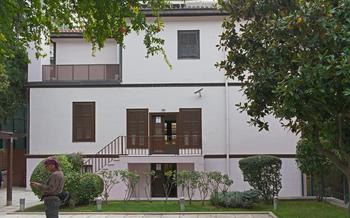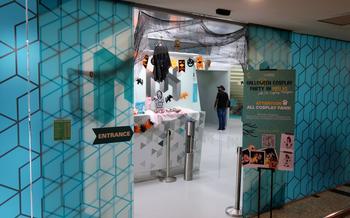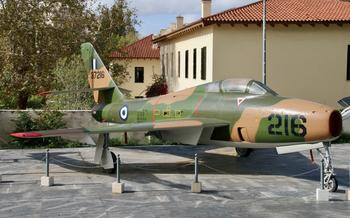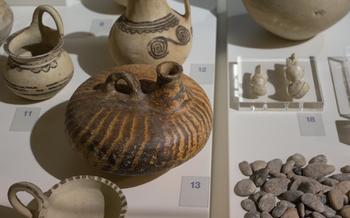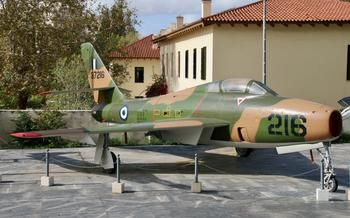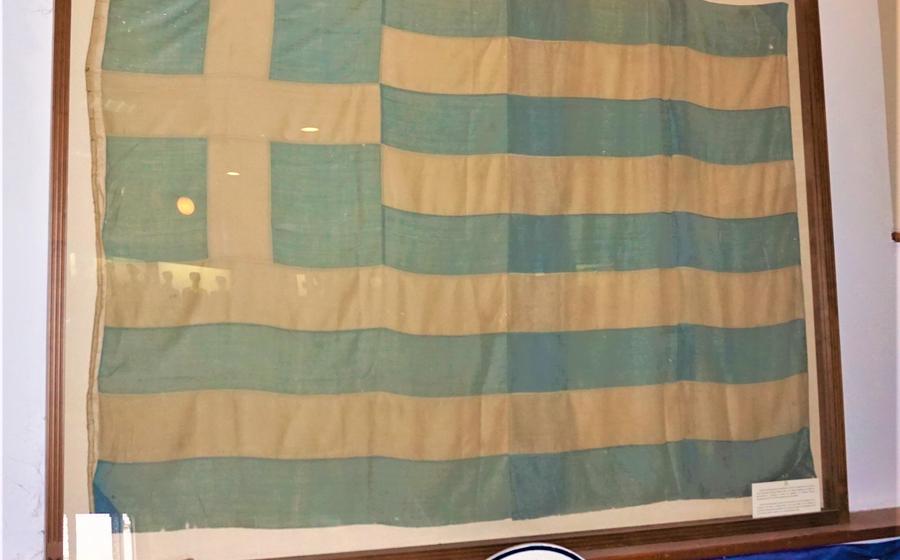
War Museum of Thessaloniki
- A City Unyielding in the Face of Siege and Strife
- The War Museum of Thessaloniki: A Testament to Resilience
- A Journey Through Time: Exploring the Museum's Exhibits
- Thessaloniki's Role in the Balkan Wars and World War I
- Thessaloniki Under Nazi Occupation: A Poignant Narrative
- Post-War Reconstruction and the City's Transformation
- Interactive Displays: Engaging Visitors with History
- Thessaloniki's Fortified Walls: A Legacy of Defense
- Personal Stories: Unveiling the Human Toll of War
- Thessaloniki's Jewish Community: A Story of Resilience
- Educational Programs and Workshops: Fostering Understanding
- Accessibility and Facilities: Ensuring an Inclusive Experience
- Insider Tip: Plan Your Visit for a Deeper Experience
A City Unyielding in the Face of Siege and Strife
Throughout history, the city of Thessaloniki has stood as a sentinel, bearing witness to the relentless march of empires and the tumultuous tides of war. Its strategic location at the crossroads of Europe and Asia has made it a coveted prize, drawing the attention of conquerors and invaders alike. From the ancient Greeks to the Romans, the Byzantines to the Ottomans, Thessaloniki has endured countless sieges and occupations, each leaving its mark on the city's rich tapestry. Yet, through it all, Thessaloniki has remained resilient, rising from the ashes of conflict time and again to reclaim its status as a vibrant and cosmopolitan hub. Today, the city's transformation from a contested battleground to a beacon of cultural and historical significance is a testament to the indomitable spirit of its people, who have tirelessly rebuilt and reinvented their beloved city, forging a legacy of resilience that continues to inspire generations.
The War Museum of Thessaloniki: A Testament to Resilience
The War Museum of Thessaloniki stands as a poignant testament to the city's indomitable spirit and unwavering resilience in the face of adversity. Established in 2000, this remarkable institution is dedicated to preserving and showcasing the stories of Thessaloniki's wartime past, paying homage to the sacrifices made by its people throughout the centuries. The museum serves as a repository of military history, offering visitors a profound insight into the city's tumultuous journey from a contested battleground to a vibrant hub of cultural and historical significance.
A Journey Through Time: Exploring the Museum's Exhibits
The War Museum of Thessaloniki is a treasure trove of historical artifacts and exhibits that take visitors on a chronological journey through the city's military past. From the ancient era to modern conflicts, the museum presents a diverse collection of weapons, uniforms, and personal belongings that bring the stories of war to life.
The museum's exhibits are arranged in a logical sequence, allowing visitors to trace the evolution of warfare and the city's role in various conflicts. Among the highlights of the collection are ancient Greek armor and weapons, relics from the Byzantine Empire, and artifacts from the Ottoman period. Visitors can also explore exhibits dedicated to the Balkan Wars, World War I, World War II, and the Greek Civil War.
Personal accounts and letters from soldiers and civilians add a human dimension to the exhibits, revealing the impact of war on individuals and their families. These poignant narratives offer a glimpse into the courage, resilience, and suffering experienced by Thessaloniki's inhabitants throughout history.
Thessaloniki's Role in the Balkan Wars and World War I
Thessaloniki played a crucial role as a strategic military base during the Balkan Wars of 1912-19The city's advantageous location on the Aegean Sea made it a vital hub for the transportation and supply of troops and equipment. As a result, Thessaloniki witnessed a significant influx of soldiers and became a bustling center of military activity.
The museum houses artifacts, documents, and personal accounts that shed light on Thessaloniki's experiences during World War I. Visitors can explore exhibits showcasing the city's role as a base for Allied forces and learn about the challenges and hardships faced by its inhabitants during the conflict.
One of the most poignant exhibits is a collection of letters written by soldiers stationed in Thessaloniki. These letters offer a glimpse into the daily lives of the men who fought on the front lines, their hopes, fears, and longing for home. They provide a powerful and deeply personal perspective on the human cost of war.
Thessaloniki Under Nazi Occupation: A Poignant Narrative
The War Museum of Thessaloniki dedicates a significant portion of its exhibition space to the city's experience during World War II, a period marked by immense suffering and resilience. Thessaloniki, once a vibrant and diverse city, fell under Nazi occupation in 1941, and its Jewish community, one of the oldest and most prominent in Europe, faced unimaginable horrors.
The museum's exhibits on this dark chapter in Thessaloniki's history include poignant personal accounts, photographs, and artifacts that shed light on the atrocities committed by the Nazi regime. Visitors can learn about the systematic persecution of the Jewish population, from the forced ghettoization and mass deportations to the extermination camps to the heroic efforts of those who risked their lives to save their fellow citizens.
One particularly moving exhibit is a replica of a cattle car used to transport Jewish families to the concentration camps. The cramped and unsanitary conditions endured by these innocent victims are a stark reminder of the dehumanization and suffering inflicted by the Nazis.
The War Museum of Thessaloniki stands as a testament to the resilience of the human spirit in the face of adversity. Through its exhibits on the Holocaust, the museum honors the memory of those who perished and pays tribute to the courage and compassion of those who resisted and survived.
Post-War Reconstruction and the City's Transformation
Thessaloniki's resilience shone brightly in the aftermath of World War II, as the city embarked on an extraordinary journey of reconstruction and transformation. Exhibits within the War Museum chronicle this remarkable chapter in Thessaloniki's history, showcasing the indomitable spirit of its people as they rebuilt their lives and their city from the ashes of war.
The museum houses a poignant collection of photographs, documents, and artifacts that narrate the city's painstaking efforts to rise from the devastation. Visitors can trace Thessaloniki's gradual transformation from a scarred battleground to a vibrant metropolis, a testament to the unwavering determination of its inhabitants.
Displays highlight innovative urban planning initiatives, the restoration of architectural landmarks, and the establishment of new industries that breathed life into the city's economy. Thessaloniki's metamorphosis into a modern, thriving hub of commerce and culture is a story of hope, perseverance, and the triumph of the human spirit over adversity.
Interactive Displays: Engaging Visitors with History
The War Museum of Thessaloniki harnesses the power of technology to create interactive and engaging exhibits that bring history to life. Multimedia displays, virtual reality experiences, and touchscreens allow visitors to delve deeper into the stories and artifacts on display. Through these interactive elements, visitors can explore historical maps, witness reenactments of battles, and even virtually try on military uniforms. These innovative displays captivate visitors of all ages, making the museum an immersive and educational experience.
Thessaloniki's Fortified Walls: A Legacy of Defense
Thessaloniki's fortified walls stand as a testament to the city's resilience and its strategic importance throughout history. Constructed over centuries, these walls have borne witness to numerous sieges and invasions, serving as a protective barrier against would-be conquerors.
The city's fortifications were initially built in the 4th century BC by Cassander, one of Alexander the Great's generals, and were later expanded and strengthened by the Romans, Byzantines, and Ottomans. The walls enclosed the city on all sides, with towers and gates strategically placed to provide defense and control access.
The walls played a crucial role in protecting Thessaloniki from attacks by various forces, including the Goths, Slavs, Bulgarians, and Normans. In the 7th century AD, the city successfully resisted a prolonged siege by the Avars and Slavs, thanks in part to the strength of its fortifications.
The walls also served as a symbol of Thessaloniki's autonomy and independence. During the Byzantine period, the city was often a target of attack by rival powers, but its strong walls and determined defenders helped to preserve its status as a free and prosperous city.
Today, the fortified walls of Thessaloniki stand as a reminder of the city's rich history and its enduring spirit. Visitors can explore the remaining sections of the walls, which offer panoramic views of the city and the surrounding countryside. The walls serve as a powerful reminder of Thessaloniki's resilience and its ability to withstand the challenges of time and adversity.
Personal Stories: Unveiling the Human Toll of War
The War Museum of Thessaloniki dedicates a significant space to sharing personal stories and experiences from soldiers and civilians who lived through the various conflicts that shaped the city's history. These accounts offer a poignant glimpse into the human cost of war and the profound impact it has on individuals and their families.
Through letters, diaries, and oral histories, visitors gain insights into the lives of ordinary people caught up in extraordinary circumstances. They hear from soldiers who fought on the front lines, describing their hopes, fears, and camaraderie. They listen to civilians who endured the hardships of occupation, recounting tales of survival, resistance, and loss.
These personal narratives humanize the statistics and bring a deeply personal dimension to the museum's exhibits. They remind visitors that war is not just about battles and strategies, but also about the countless human lives that are forever changed by its devastation.
One particularly moving exhibit features a collection of letters written by a young soldier to his family during World War I. In his heartfelt words, he expresses his longing for home, his fears for the future, and his unwavering love for his loved ones. These letters offer a glimpse into the inner thoughts and emotions of a young man facing the horrors of war, and they serve as a powerful reminder of the sacrifices made by countless soldiers throughout history.
By sharing these personal stories, the War Museum of Thessaloniki not only preserves the memory of those who lived through these tumultuous times but also encourages visitors to reflect on the devastating consequences of war and the importance of peace and reconciliation.
Thessaloniki's Jewish Community: A Story of Resilience
Thessaloniki was once home to a vibrant and thriving Jewish community, one of the largest and oldest in Europe. Its roots can be traced back to the Roman period, and by the early 20th century, the city's Jewish population numbered over 50,000. They were an integral part of the city's social, cultural, and economic fabric, contributing significantly to its development.
However, this vibrant community was tragically shattered during World War II. In 1941, Thessaloniki fell under Nazi occupation, and the Jewish population faced unimaginable horrors. Over 45,000 Jews were forcibly deported to concentration and extermination camps, where the vast majority perished. It was a devastating blow to the city and its Jewish community, a loss that is still felt today.
Despite this tragic chapter in its history, Thessaloniki's Jewish community has shown remarkable resilience. After the war, survivors returned to the city and began to rebuild their lives. Today, a small but vibrant Jewish community remains in Thessaloniki, dedicated to preserving their heritage and culture.
The War Museum of Thessaloniki pays tribute to the city's Jewish community and its tragic fate during the Holocaust. Through exhibits, artifacts, and personal testimonies, the museum sheds light on the vibrant life of the community before the war and the horrors it endured under Nazi occupation. It is a powerful reminder of the human cost of war and the importance of remembering and learning from the past.
Educational Programs and Workshops: Fostering Understanding
The War Museum of Thessaloniki extends its reach beyond its exhibits by offering a range of educational programs and workshops designed to engage students, researchers, and the general public. These initiatives aim to promote a deeper understanding of the city's military history and its broader implications.
School groups are encouraged to visit the museum as part of their curriculum, where they can participate in interactive workshops that bring history to life. These workshops delve into specific themes related to the museum's exhibits, allowing students to engage with the content in a hands-on and collaborative manner.
The museum also hosts seminars and lectures by renowned historians and experts, providing a platform for scholarly discourse and the exchange of ideas. These events offer attendees the opportunity to delve into specific aspects of Thessaloniki's military history, gain insights from leading authorities, and engage in thought-provoking discussions.
By fostering a culture of learning and critical thinking, the War Museum of Thessaloniki plays a vital role in promoting peace education and reconciliation. It encourages visitors to confront the complexities of war, examine its human toll, and work towards building a more peaceful future.
Accessibility and Facilities: Ensuring an Inclusive Experience
The War Museum of Thessaloniki is committed to providing an inclusive and accessible experience for all visitors. The museum features ramps, elevators, and accessible restrooms, making it easy for visitors with disabilities to navigate the exhibits. Visitors can also request assistance from the museum staff, who are always happy to help.
In addition to its accessibility features, the museum also offers a variety of amenities to make your visit more enjoyable. There is a cafeteria where visitors can purchase snacks and drinks, as well as a gift shop where they can find souvenirs and educational materials. The museum also has a cloakroom where visitors can store their belongings while they explore the exhibits.
Insider Tip: Plan Your Visit for a Deeper Experience
To fully immerse yourself in the historical tapestry of Thessaloniki, consider visiting the War Museum during off-peak hours. This will allow you to navigate the exhibits at your own pace, absorbing the stories and artifacts without the hustle and bustle of crowds. The museum's tranquil ambiance during these quieter hours provides an opportunity for deeper contemplation and reflection.
Enhance your visit by combining it with a guided tour of Thessaloniki's other significant historical landmarks. This will provide a comprehensive understanding of the city's rich past and its transformation from a contested battleground to a vibrant cultural hub. Engage with knowledgeable guides who can share insights and anecdotes, bringing the city's history to life. Embrace the opportunity to delve into Thessaloniki's captivating narrative and gain a profound appreciation for its resilience, diversity, and enduring spirit.
